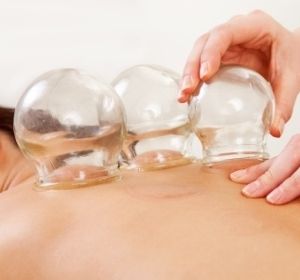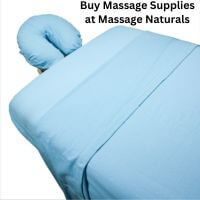- Home
- Western Massage
- Cupping Massage
As an affiliate for Bookshop, Amazon, and other programs, I may earn a small commission for products purchased through links. This doesn't affect the price you pay. Privacy policy and disclosures.
Search this site:
What Is a Cupping Massage and It's Benefits?
Cupping massage gives you a deep massage without deep pressure. The cups create suction and negative pressure that lifts and separates the layers of soft tissue, rather than compressing them. The separation of soft tissues helps improve blood circulation and release constricted fascia.
Traditional Chinese Cupping
Cupping therapy is part of Traditional Chinese Medicine (TCM). Practitioners place a flame inside a glass, bamboo, or pottery cup to create a vacuum in the cup and then quickly put the cup's open end on your body.
The cup's vacuum suction creates a seal that lifts your skin and underlying tissue (the lifting is called negative pressure). Usually, TCM practitioners let the cups remain in one location for about ten minutes (stationary or retained cupping). However, sometimes practitioners move the cups (running or gliding cupping) on the skin or place the cup and immediately remove it (flash cupping).
The two types of cupping are dry and wet. In dry cupping, the cups can slide across the skin or remain in place. In wet cupping, the practitioner uses a cup to create mild suction, removes the cup, uses a small scalpel to make a tiny cut on the skin, and then places a second suction to draw a tiny amount of blood.
According to TCM theory, what does cupping massage do? Cupping facilitates the movement of Qi and blood; helps relieve excess heat conditions, fever, stress, depression and anxiety; and dispels wind, damp, and cold to help relieve muscle and joint pain, stiffness, and arthritis. For more about Chinese cupping, see Practical Guide to Cupping Therapy: A Natural Approach to Heal Through Traditional Chinese Medicine.
Although modern dry cupping massage is based largely on TCM therapy, cupping has an ancient history and was used in the United States until the early 1900s. For more information, see Cupping Therapy: An Overview from a Modern Medicine Perspective.
What is a Cupping Massage?
Dry cupping started showing up in Western massage around the 1990s. Massage therapists primarily use the cups to do massage strokes (after applying oil to your skin), although they may also leave the cups stationary. Cupping massage techniques include making long strokes along your muscles, using the edge of the cup to scoop over a muscle, and making vigorous circles.
Some massage therapists use fire cupping massage as described above, but this approach requires specialized training and caution. A newer way to do cupping is either with silicone cups, recommended for easy movement and gliding, or a manual vacuum set that uses plastic cups. With vacuum cups, the therapist places a cup on your skin and then attaches a pump. The pump removes the air from the cup, creating a vacuum and negative pressure.
The massage therapist can adjust the cupping pressure to be light, medium, or deep, depending on your condition and needs.
Massage cupping benefits, according to the International Cupping Therapy Association, include:
- Sedates the nervous system and relaxes tight muscles
- Stretches muscle and connective tissues
- Promotes blood circulation and flow of lymphatic fluid, supporting the healing process
- Reduces inflammation
- Breaks up and expels systematic congestion
- Releases adhesions (stuck together tissue)
More About Massage Cupping
When the suction of cupping draws the skin up into the cup, surface blood vessels expand, potentially causing redness or discoloration that resembles a bruise. The discoloration usually is not painful and goes away in a few days.
Reasons not to receive a cupping massage include skin inflammation (including sunburn), high fever, convulsions, or cramping, or if you bleed easily. Don’t receive cupping if you take a blood thinning medication. Also avoid cupping near a wound or skin ulcer or if you have an internal organ disorder or have experienced recent trauma.
Other medical conditions may also contraindicate cupping, so make sure to tell your massage therapist about all your medical conditions.
After you massage, avoid excessive heat for about 20 minutes, don't exercise or over exert yourself for a few hours, and drink plenty of water.
Resource: Cupping Therapy Encyclopedia
What Is a Cupping Massage Video Demo

Buy essential oils from Aromatics International (recommended).
Rocky Mountain Essential Oils.
Photo Credit: leaf/123RF Stock Photo




